Breaking news
Ukraine Captures Russian FPV Drone Equipped with 220 mm BM-27 Projectile.
According to a tweet from Ukrainian Front dated June 5, 2024, the Ukrainian military successfully intercepted and captured a Russian FPV (First Person View) drone equipped with an unusual system. The captured drone was equipped with a 220 mm 9M27K3 projectile, originally designed for the BM-27 "Uragan" multiple rocket launcher system.
Follow Army Recognition on Google News at this link

A Russian FPV drone equipped with a 220 mm 9M27K3 projectile, originally designed for the BM-27 "Uragan" multiple rocket launcher system. (Picture source: Social Media)
The BM-27 "Uragan" is a Soviet-era multiple rocket launcher system designed to deliver massive firepower and rapid saturation on the battlefield. Entering service in the 1970s, the BM-27 is mounted on an all-terrain truck chassis, providing it with high mobility and the capability to quickly deploy in various terrain conditions. It is equipped with 16 launch tubes of 220 mm, capable of firing a variety of rockets, including explosive, incendiary, chemical projectiles, and those containing submunitions such as anti-personnel mines, which seem to be equipped on the drone captured by Ukrainian forces.
Each salvo of rockets can cover a wide area, making the BM-27 particularly effective in neutralizing troop concentrations, and enemy infrastructure, and creating minefields. Its maximum range is about 35 kilometers, and its ability to deliver rapid and devastating firepower makes it a formidable weapon in modern conflicts.
The 9H223 KPFM-1C cartridge, combined with the 220 mm 9M27K3 projectile, constitutes an advanced component of the Russian arsenal, designed to be used with the BM-27 "Uragan" multiple rocket launcher system. This combination of cartridge and projectile represents a sophisticated solution for dispersing anti-personnel mines on the battlefield.
The 220 mm 9M27K3 projectile is specifically designed for the BM-27 "Uragan," a multiple rocket launcher capable of firing a variety of munitions at a range of about 35 kilometers. This particular projectile is intended to contain and disperse anti-personnel submunitions, specifically the PFM-1 "Petal" mines. The 9M27K3 carries a payload of 26 of these mines, known for their distinctive shape that resembles a butterfly, hence their nickname.
PFM-1 "Petal" mines are designed to be difficult to detect and neutralize. They are lightweight, made of plastic, and deployed to scatter over a wide area, making the task of mine clearance extremely complex and dangerous. These mines are pressure-sensitive and can cause severe injuries to civilians.
The 9H223 KPFM-1C is the cartridge used to propel the 9M27K3 projectile. This cartridge ensures the stability and accuracy of the launch, guaranteeing that the projectile reaches its intended target before releasing the mines. The design of the cartridge and projectile results from years of technological development aimed at maximizing the efficiency of mine dispersion and minimizing the chances of failure in flight or upon impact.
While drones are now well-known, the combination of a projectile designed for an MLRS and an FPV drone was previously unknown. It is easy to understand what drove the Russian forces to mount such a system on a drone, as automation is a significant factor in the Russo-Ukrainian conflict. However, the role fulfilled by the drone is not quite the same as that of the BM-27. The BM-27 is designed to saturate an area, which is not the case here; the drone should be seen more as a precise tool, carrying out more targeted missions while conserving resources.
However, a swarm of drones equipped with such devices could fulfill the same role as the BM-27 and would undoubtedly be remarkably effective. But the model here seems very artisanal, and large-scale production does not seem to be on the agenda.

The BM-27 "Uragan" is a Soviet-era multiple rocket launcher system. ( Picture Source: Vitaly V.Kuzmin)


























